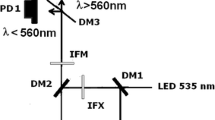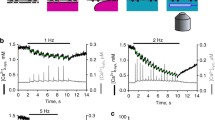Abstract
The effects of changes in luminal [Ca2+] have been investigated in sheep skeletal sarcoplasmic reticulum (SR) Ca2+-release channels after activation of the channels by different ligands from the cytosolic side of the channel. Native heavy SR membrane vesicles were incorporated into planar phospholipid bilayers under voltage-clamp conditions. Experiments were carried out in symmetrical 250 mm Cs+. Lifetime analysis indicates that channels activated solely by cytosolic Ca2+ exhibit at least two open and five closed states. The open events are very brief and are close to the minimum resolvable duration. When channels are activated solely by cytosolic Ca2+, luminal Ca2+ does not appear to exert any regulatory effect. The P 0 and duration of the open and closed lifetimes are unchanged. However, if channels are activated by ATP alone or by ATP plus cytosolic Ca2+, increases in luminal [Ca2+] produce marked increases in P 0 and in the duration of the open lifetimes. Our results demonstrate that maximum activation of the skeletal SR Ca2+-release channel by ATP cannot be obtained in the absence of millimolar luminal [Ca2+].
Similar content being viewed by others
References
Ashley, C.C., Mulligan, I.P., Lea, T.J. 1991. Calcium and activation mechanisms in skeletal muscle. Quart. Rev. Biophys. 24:1–73
Ashley, R.H., Williams, A.J. 1990. Divalent cation activation and inhibition of single calcium release channels from sheep cardiac sarcoplasmic reticulum. J. Gen. Physiol. 95:981–1005
Bers, D.M. 1991. Excitation-contraction coupling and cardiac contractile force, Dordrecht: Kluwer
Blatz, A.L., Magleby, K.L. 1986. A quantitative description of 3 modes of activity of fast chloride channels from rat skeletal muscle. J. Physiol. 378:141–174
Chu, A., Fill, M., Stefani, E., Entman, M.L. 1993. Cytoplasmic Ca2+ does not inhibit the cardiac muscle sarcoplasmic reticulum ryanodine receptor Ca2+ channel, although Ca2+-induced Ca2+ inactivation of Ca2+ release is observed in native vesicles. J. Membrane Biol. 135:49–59
Colquhoun, D., Sigworth, F.J. 1983. Fitting and statistical analysis of single-channel recording. In: Single-channel recording. B. Sakmann and E. Neher, editors, pp. 191–263. Plenum, New York
Fabiato, A. 1985. Time and calcium dependence of activation and inactivation of calcium-induced release of calcium from the sarcoplasmic reticulum of a skinned canine cardiac Purkinje cell. J. Gen. Physiol. 85:247–289
Ikemoto, N., Ronjat, M., Meszaros, L.G., Koshita, M. 1989. Postulated role of calsequestrin in the regulation of calcium release from the sarcoplasmic reticulum. Biochemistry 28:6764–6771
Maylie, J., Irving, M., Sizto, N.L., Boyarsky, G., Chandler, W.K. 1987. Calcium signals recorded from cut frog twitch fibers containing tetramethylmurexide. J. Gen. Physiol. 89:145–176
Miller, C. 1982. Open-state substructure of single chloride channels from Torpedo electroplax. Phil. Trans. R. Soc. Lond. 299:401–411
Moczydlowski, E., Latorre, R. 1983. Gating kinetics of Caactivated K-channels from rat muscle incorporated into planar lipid bilayers. Evidence for 2 voltage-dependent Ca2+ binding reactions. J. Gen. Physiol. 82:511–542
Otsu, K., Willard, H.F., Khanna, V.K., Zorzato, F., Green, N.M., MacLennan, D.H. 1990. Molecular cloning of cDNA encoding the Ca2+ release channels (ryanodine receptor) of rabbit cardiac muscle sarcoplasmic reticulum. J. Biol. Chem. 265:13472–13483
Rios, E., Ma, J.J., Gonzalez, A. 1991. The mechanical hypothesis of excitation-contraction (EC) coupling in skeletal muscle. J. Muscle. Res. Cell Mot. 12:127–135
Rios, E., Pizarro, G. 1991. Voltage sensor of excitation-contraction coupling in skeletal muscle. Physiol. Rev. 71:849–907
Shomer, N.H., Louis, C.F., Fill, M., Litterer, L.A., Mickelson, J.R. 1993. Reconstitution of abnormalities in the malignant hyperthermia-susceptible pig ryanodine receptor. Am. J. Physiol. 264:C125-C135
Sitsapesan, R., Montgomery, R.A.P., MacLeod, K.T., Williams, A.J. 1991. Sheep cardiac sarcoplasmic reticulum calcium release channels: modification of conductance and gating by temperature. J. Physiol. 434:469–488
Sitsapesan, R., Williams, A.J. 1990. Mechanisms of caffeine activation of single calcium-release channels of sheep cardiac sarcoplasmic reticulum. J. Physiol. 423:425–439
Sitsapesan, R., Williams, A.J. 1994. Regulation of the gating of the sheep cardiac sarcoplasmic reticulum Ca2+-release channel by luminal Ca2+. J. Membrane Biol. 137:215–226
Sitsapesan, R., Williams, A.J. 1994. Gating of the native and purified cardiac SR Ca2+-release channel with monovalent cations as permeant species. Biophys. J. 67:1484–1494
Smith, J.S., Coronado, R., Meissner, G. 1986. Single channel measurements of the calcium release channel from skeletal muscle sarcoplasmic reticulum. J. Gen. Physiol. 88:573–588
Stern, M.D. 1992. Theory of excitation-contraction coupling in cardiac muscle. Biophys. J. 63:497–517
Tinker, A., Lindsay, A.R.G., Williams, A.J. 1992. Block of the sheep cardiac sarcoplasmic reticulum Ca2+-release channel by tetraalkylammonium cations. J. Membrane Biol. 127:149–159
Tinker, A., Lindsay, A.R.G., Williams, A.J. 1993. Cation conduction in the cardiac sarcoplasmic reticulum calcium-free channel under physiological and pathophysiological conditions. Cardiovasc. Res. 27:1820–1825
Tinker, A., Williams, A.J. 1992. Divalent cation conduction in the ryanodine receptor-channel of sheep cardiac muscle sarcoplasmic reticulum. J. Gen. Physiol. 100:479–493
Tu, Q., Velez, P., Cortes-Gutierrez, M., Fill, M. 1994. Surface charge potentiates conduction through the cardiac ryanodine receptor channel. J. Gen. Physiol. 103:853–867
Volpe, P., Simon, B.J. 1991. The bulk of Ca2+ released to the myoplasm is free in the sarcoplasmic reticulum and does not unbind from calsequestrin. FEBS Lett. 278:274–278
Williams, A.J., Holmberg, S.R.M. 1990. Sulmazole (AR-L 115BS) activates the sheep cardiac muscle sarcoplasmic reticulum calcium-release channel in the presence and absence of calcium. J. Membrane Biol. 115:167–178
Author information
Authors and Affiliations
Additional information
We are grateful to the British Heart Foundation for financial support.
Rights and permissions
About this article
Cite this article
Sitsapesan, R., Williams, A.J. The gating of the sheep skeletal sarcoplasmic reticulum Ca2+-release channel is regulated by luminal Ca2+ . J. Membarin Biol. 146, 133–144 (1995). https://doi.org/10.1007/BF00238004
Received:
Revised:
Issue Date:
DOI: https://doi.org/10.1007/BF00238004




